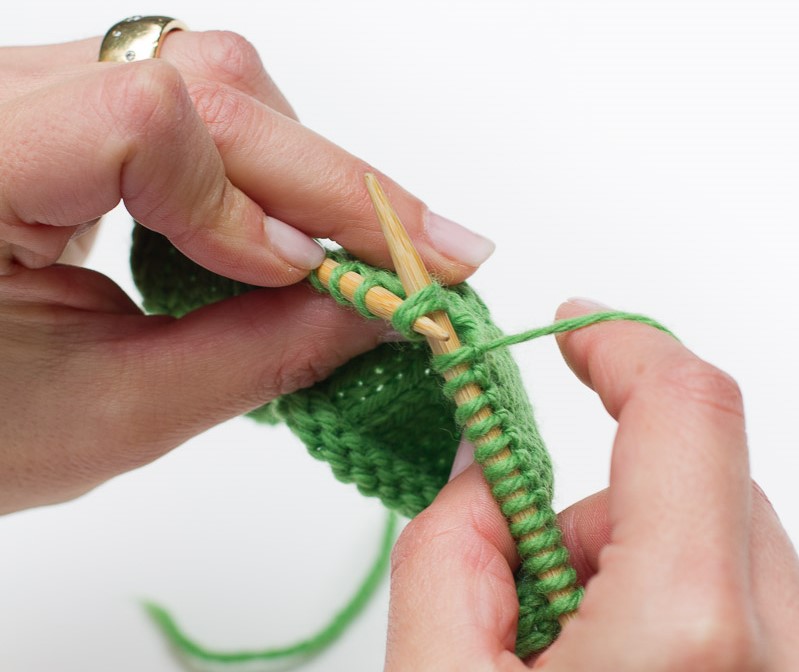
These are my two favourite definitions. Feel free to steal them.
SSK: Slip the next two stitches, knitwise, individually. Return them to the left needle without twisting and knit them together through the back loop.
SSK: Slip the next two stitches, knitwise, individually. Insert the tip of the left needle, from left to right, into the fronts of these two stitches, and knit them together.
UPDATE: Answers to two other questions I’ve been asked…
K2tog-tbl does not produce the same result as SSK: with k2tog-tbl the stitches get twisted (they don’t in the SSK). The two stitches do look different. It’s more noticeable in some fabrics than others, and as long as you’re consistent it’s not a bad substitute. But it does NOT look the same. SKP is a better substitute, and indeed, I teach SSK and SKP as being interchangeable.
SKP = Slip the next stitch knitwise, knit the following, then lift the slipped stitch up, over and off the needle (which is the P in this, ‘pass slipped stitch over’.)
SKP and SSK do look slightly different, in that the angle of the stitch lying onto of the fabric is the same, but as long as you’re consistent, you can cheerfully interchange them.
And if you don’t like the ‘wiggly line’ that sits above a column of SSK decreases, work the stitch that sits above the decrease, in the even rows/rounds, tbl. It tidies the line up very nicely.
Everyone has things that annoy them. Everyone has “triggers” that send them off on little rants. For my husband, it’s when TVs in electronic stores are set to the wrong aspect ratio, distorting the image.
For me, it’s about SSK and the definition provided.
I have been known to go off on Twitter rants on this topic. I write about it on a regular basis. I talk about it in my pattern writing class. If you’re a tech editing client who sends me a pattern with the problematic definition, you’re likely to get a lecture. If you say the wrong thing in class I will stop the class to talk about it. I actually threatened to my publisher to withdraw my permission to publish a book over it.
Here’s the issue: when a pattern glossary ‘helpfully’ provides the following ‘definition’ for that decrease..
SSK: Slip, slip, knit.
(UGH I CAN BARELY TYPE IT IT MAKES ME SO ANGRY.)
Or, equally, if someone uses that phrase as the name of stitch, saying it out loud.
Follow those instructions. Just try it. I mean, first of all, it doesn’t tell you how to slip the stitches – knitwise or purlwise – but even more important than that, you don’t actually get a decrease. That ‘definition’ tells you to slip two stitches, and then knit a third. There’s an essential problem with this stitch ‘name’. If you spell out the words, you get an instruction.
Standard knitting terminology has taught knitters to expect that if they spell out the words in the abbreviation, you’ll get the instruction. If you spell out the words in the usual abbreviations, e.g. k2tog, p2tog, skp… you get words that describe (albeit tersely), the steps required to make the stitch happen. K2tog = knit two together. Perfect.
But if you spell out the words in SSK you get an instruction that is utterly and entirely incorrect. So why on earth do we think that “slip, slip, knit” is adequate as an explanation? It’s not. And to include that in the stitch glossary is actually HARMFUL. Yes, I did just say that.
If you know how to do SSK, then you don’t need any help. And if you don’t, those three awful words actually tell you the wrong thing.
Now, I’m regularly told that people should be told – or want to know – “where the letters come from”. No-one has yet convinced me that this provides any value, but I remain open to being convinced on this point. But if you’re going to include SSK in your glossary – whether you ‘spell out’ the words or not — you MUST give a full and proper definition. I’ve provided two versions to the left.
“Slip, slip, knit” on its own is NOT an instruction. And if you’re not going to include an actual instruction, don’t bother including it in the glossary. Save yourself the lecture… 🙂
(And some other day we’ll talk about the way YO and m1 are handled in the glossaries. They’re just as bad.)
